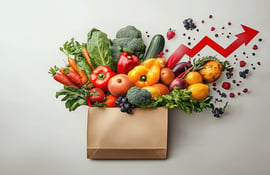Your inventory is the lifeblood of your restaurant. Composed of all the supplies needed to make your restaurant function, keeping track of what you have in stock has a major impact on your daily service.
While there may be restaurants that “wing” their restaurant inventory management system, in order to track inventory effectively, you have to take it seriously. Here’s more info and tips on restaurant inventory management to set you up for success.
What Is Inventory Management?
Inventory management is the process of tracking your restaurant inventory to prevent loss and keep an eye on profits. There are three main things you want to track when managing your inventory:
-
Inventory coming in: Beginning inventory includes supplies that are coming in the door of your restaurant — raw materials you have ordered from a vendor.
-
Inventory that is used: You’ll want to track what inventory is being used during service. You can often track this inventory by looking at how much stock you have at the beginning of an inventory period, compared to what you have at the end. Which naturally brings us to…
-
Ending inventory: This is the inventory you are left with at the end of any given tracking period. Monitoring this helps determine your inventory turnover and gauge your cost of goods sold (COGS).
Now, inventory checking periods are up to you, but generally speaking, perishable items that move quickly should be checked weekly. Materials like glassware, appliances, cleaning supplies can be checked on a monthly or quarterly basis.
Why Is It Important?
There are many good reasons to check your inventory. On a very basic level, inventory management will help ensure you always have essential materials on hand. The last thing you need is to run out of key ingredients in the middle of a busy service. However, here are a few other reasons to do inventory management at your restaurant.
-
Combat food waste: Up to 10% of food is wasted in a restaurant before it ever has a chance to meet the customer’s plate, which hurts your profits and your restaurant’s sustainability practices. Employing the first in, first out (FIFO) system can reduce spoilage and allow better use of inventory before the expiration date hits.
-
Achieve better food cost percentages: Track the nitty-gritty details about recipe costing and food cost percentages to control costs, avoid over-ordering, and drive more revenue.
-
Have more peace of mind: Effectively managing restaurant inventory levels means you don’t have to worry about making unexpected, time-consuming adjustments to your menu, which can cause stress for you and your staff members.
-
Calculate accurate profit margins: If you don’t know how much of your sitting inventory is being used, it’s going to be really hard for you to calculate your restaurant’s bottom line accurately.
-
Highlight problem ingredients: If the same ingredients deplete quickly over and over, that could indicate discrepancies in usage or forecasting errors, driving you to start investigating why and how fix those problems.
What might be causing areas of loss in your inventory? We thought you'd never ask! Check into these usual suspects first:
-
Spoilage: When food goes bad before you can use it
-
Spillage: When food ingredients get spilled and therefore can not be used for service
-
Employee mistakes: When food gets rung up incorrectly, delivered to the wrong table, etc.
-
Unhappy guests: When food is comped to smooth over a negative customer experience
-
Family meals: When inventory is used for a communal staff meal before, during or after service
-
Breakage: When plates, glasses, etc. break during service
-
Theft: When inventory items are stolen from your restaurant
Best Practices for Inventory Management
Seventy-five percent of restaurants struggle with profits because of their food costs. Good inventory management software can help you combat this issue, but you need to be smart about it. As you begin to build more processes around tracking inventory, here are some tips to keep in mind:
-
Have a process for receiving inventory. Running a restaurant, you are going to have deliveries coming in before and sometimes even during service. Many can fall at the same time on the same day, which can prove to be a little overwhelming. Have a set process for receiving orders. We suggest making sure that the items and the quantities being dropped off match the delivery invoice before signing off. Have the person receiving the delivery also add their initials and the date to the invoice in case you need to go back and ask your staff for additional info.
-
Train your staff on inventory. Restaurants are busy places with many needs that often spring up at the same time. Training your staff on inventory will allow you to tap them for assistance receiving, entering and checking inventory. When they are trained they can also keep an extra eye out for when supplies get low.
-
Establish par levels. Par is the minimum amount of inventory that you require for each item. If your inventory is below par, you know it’s time to reorder.
-
Schedule weekly and monthly days for inventory. Create an official inventory sheet and assign taking inventory as a specific part of a shift. This makes tracking inventory fluctuations a nonnegotiable priority.
Options for Managing Your Restaurant Inventory
In the restaurant industry, there are tons of different options available when it comes to the actual act of tracking stock levels and inventory costs.
Let’s tackle tech first. Generally speaking, there are two routes you can take. You can consider getting a POS (point-of-sale system) that handles inventory control. (For more on POS systems, check out our comprehensive guide.)
Next, you can look into inventory management apps that save time and let restaurant operators manage inventory needs from their phone or computer. Here are some things to keep in mind as you are scoping out if this tech is right for your restaurant:
-
Price: Is it a one time fee or a subscription model? Does it fit within your monthly and annual budget?
-
Ingredient-level tracking: How granular is tracking when it comes to food? Can it track ingredients connected to where they are used on the menu?
-
Ease of use: Is it user friendly for you and your staff? Can people be trained on it quickly?
-
Integrations: Does it easily integrate and communicate with other technologies you are using for your restaurant, such as POS or Excel systems?
-
Customer support: Are you able to access support 24/7 if something goes wrong? Are there resources or account managers available to help you optimize your inventory using the technology?
If tech solutions don’t fit your needs, then the next best thing is to create an inventory spreadsheet for your restaurant. This is a document that will allow you to physically go in and track your inventory counts week to week.
Here are some examples, but you should make your inventory tracking sheet fit your restaurant’s needs.
Start Tracking Your Inventory Data the Right Way
The right inventory-tracking software can help you streamline your daily tasks, give you real-time updates on what’s in stock, use automation to save time, cut down on labor costs, keep your supply chain running smoothly, and let you stay on top of your cash flow.
However, not every inventory-management solution works for every restaurant. We beg you — please, please, please don't try to track inventory in your head! It’s just going to cause chaos in your kitchen. Trust us — your front- and back-of-house staff will thank you!
If you want more information about inventory management systems and how they can save you time and money, reach out for a free consultation.




